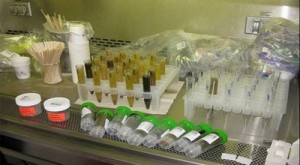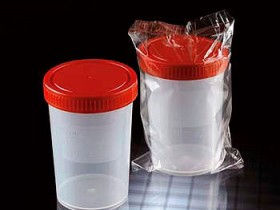- Deciphering the results of analyzes on a dysbacteriosis
- pathogenic enterobacteria
- colon bacillus (Escherichia coli, or in abbreviated form e. сoli)
- lactosonegative enterobacteria
- lactobacilli
- bifidobacteria
- Enterococci
- clostridia
- Proteus
- Klebsiella
- bacteroides
- peptostreptokokki
- staphylococci
- yeast-like fungi, related to the genus Candida
 Human Intestine contains large amounts of bacteria, who are actively involved in the digestion of nutrients.
Human Intestine contains large amounts of bacteria, who are actively involved in the digestion of nutrients.
Usually, pass fecal bacteria overgrowth prescribed for children and adults, in which the symptoms of bowel pronounced, namely marked flatulence, constipation, diarrhea, abdominal pain, and after receiving antibiotics.
Deciphering the results of analyzes on a dysbacteriosis
pathogenic enterobacteria
These bacteria, often, They are responsible for many human diseases. They cause the development of acute intestinal infections. In particular we are talking about Salmonella, Shigella - dysentery exciter. The presence of these microorganisms in the stool analysis indicates the development of a fairly serious infectious bowel disease. In other words, in the normal analysis of dysbacteriosis this indicator should not contain.
colon bacillus (Escherichia coli, or in abbreviated form e. сoli)

Normally E. coli is part of the flora of the gastrointestinal tract. It prevents colonization of opportunistic intestinal microflora, and generates vitamins "B" and promotes absorption of calcium in the organism and iron.
By reducing the total number of Escherichia coli suggests, that is dangerous parasites in the gut (worms). Besides, there may be other reasons:
- antibiotic treatment;
- malnutrition (excess carbohydrates, proteins or fats, artificial feeding and the wrong diet);
- the presence of intestinal infections.
Quite common reducing its enzymatic activity. In this case, E. coli is deficient, in other words it does not harm the body, but absolutely does not bring benefits. If it exceeds the norm, it indicates the beginning of the development of dysbiosis.
Norma e. coli for all ages and is the same 10 7 – 10 8.
lactosonegative enterobacteria
This name is characteristic of opportunistic bacteria, which interfere with the normal digestion of food and cause dyspepsia: posseting, belching, heartburn, feeling, that belly bursting, or vice versa squeezed.
Normally, these bacteria should not exceed 5%.
lactobacilli
These bacteria are among the main microorganisms in the group of lactic acid. They take the total mass of bacteria in the gut – 4-6%. Lactobacillus lactose is digested and thereby prevent the development of lactose deficiency. Their task - is to support normal levels of acidity in the large intestine.
Lowering the bacteria in the analysis shows:
- carrying out medical treatment, during which used antibiotics and nonsteroidal antiinflammatory drugs;
- unhealthy diet;
- intestinal infection;
- the presence of chronic diseases of the gastrointestinal tract;
- stress.
Norma lactobacilli:
- for children aged up to one year – 106 – 107;
- for children over one year - 10 7 – 108;
- for adults - 106 – 108.
bifidobacteria
No less important type of bacteria in the intestinal microflora. Their main property serves inhibition of bacteria in the gut boleznotvornyh. In the gut bifidobacteria not less 95%. Deficiency of this bacterial species - is one of the pathogenic factors, which reveal a breach.
Reasons for the decrease of bifidobacteria in the gut act:
- antibiotics and laxatives;
- malnutrition;
- Gastrointestinal chronic nature of the disease;
- intestinal infection;
- fermentopathy;
- allergies and immune deficiency;
- climate change;
- a variety of stressful situations.
Enterococci
This type of bacteria - it is the inhabitants of the normal flora of the gastrointestinal tract, its constituent. At the same time they are the causative agents, which cause an infection in the pelvic and urinary organs. Number of enterococci should not be more than Escherichia coli. Their increase indicates the presence of diseases such as:
- food allergies;
- lowered immunity or immune diseases;
- the presence of parasites;
- wrong pitaenie.
Normally, their number should be 105-108.
clostridia
Also, representatives of the normal flora of the colon. They are involved in protein processing. Their increase is evidence of the consumption of large amounts of protein products. their norm:
- grudnichkovyh for children should not exceed 103;
- for children over one year and adults - 105.
Proteus

Representative normal and stable pathogenic intestinal flora. This type of bacteria called sanitary-indicative. The presence in the analysis on a dysbacteriosis says about pollution of the body.
Data can become infected with bacteria at non-observance of personal hygiene or transfer of the patient.
Klebsiella
A representative of the opportunistic bacteria, belonging to the family Enterobacteriaceae. The presence in the microflora of the gut is the norm, provided, that its rate does not exceed 104.
bacteroides
This type of bacteria is involved in the digestion of food. Usually, in the analysis of stool in children the first six months of life, this indicator is not. For children older than seven months and in adults, this indicator should not be more 108. true, before the end of the role of this bacterium in humans has not been studied.
peptostreptokokki
They live in the large intestine, take part in the processing of milk protein and carbohydrates. However, the excess peptostreptokokkov standards body, as well as their presence in other areas of the body indicates the presence of inflammation.
The norm of the bacterium:
- for children up to one year - 103 – 105;
- for children over one year and adults - 105 – 106.
staphylococci
Separate the active type on pathogenic bacteria (plazmokoahulyruyuschye, haemolytic and Staphylococcus) and non-pathogenic (epidermal and non-hemolytic)
The organism Staphylococcus adjudged with food from the external environment. Normally, when depositing on a dysbacteriosis analysis it shall not be. It is worth noting, that the presence of Staphylococcus aureus in the analysis results require immediate hospitalization.
yeast-like fungi, related to the genus Candida
Their growth can be an indicator of the use of antibiotics and to talk about the development of dysbiosis. Normally, this figure should not exceed 107.
Finally it is worth to add, that the transcript of the analysis on a dysbacteriosis presented above can not be predetermined for all age groups. Even in normal assays can differ. Moreover, should focus on the laboratory performance standards, which for tests.



 (3 votes, average rating 4.67 of 5)
(3 votes, average rating 4.67 of 5)





Leave a Reply